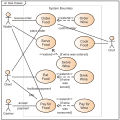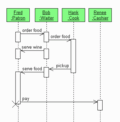- Component (UML)
-
A UML Component with provided and required interfaces

A component in the Unified Modeling Language "represents a modular part of a system, that encapsulates its content and whose manifestation is replaceable within its environment. A component defines its behavior in terms of provided and required interfaces".[1]
A component may be replaced by another if and only if their provided and required interfaces are identical. This idea is the underpinning for the plug-and-play capability of component-based systems and promotes software reuse[1].
As can be seen from the above definition, UML places no restriction on the granularity of a component. Thus, a component may be as small as a figures-to-words converter, or as large as an entire document management system.
Larger pieces of a system's functionality may be assembled by reusing components as parts in an encompassing component or assembly of components, and wiring together their required and provided interfaces."[1] Such assemblies are illustrated by means of component diagrams.
Related terms
- Package (UML)
References
- ^ a b c OMG (2008). OMG Unified Modeling Language (OMG UML), Superstructure, V2.1.2 p.146.
External links
Unified Modeling Language Actors Organizations: Object Management Group • UML Partners Persons: Grady Booch • Ivar Jacobson • James Rumbaugh


Concepts Object oriented: Object-oriented programming • Object-oriented analysis and design
Structure: Actor • Attribute • Artifact • Class • Component • Interface • Object • Package • Profile diagram
Behavior: Activity • Event • Message • Method • State • Use case
Relationships: Aggregation • Association • Composition • Dependency • Generalization (or Inheritance)
Extensibility: Profile • Stereotype
Other concepts: MultiplicityDiagrams StructuralBehaviourActivity diagram • State Machine diagram • Use case diagramInteractionDerived languages Systems Modeling Language (SysML) • UML eXchange Format (UXF) • XML Metadata Interchange (XMI)Other topics Categories:- Unified Modeling Language
- Unified Modeling Language stubs
Wikimedia Foundation. 2010.
